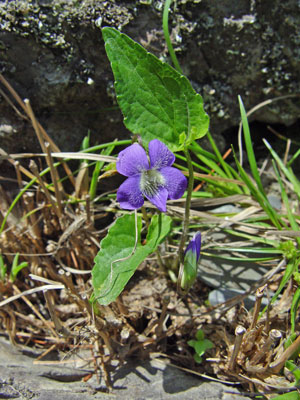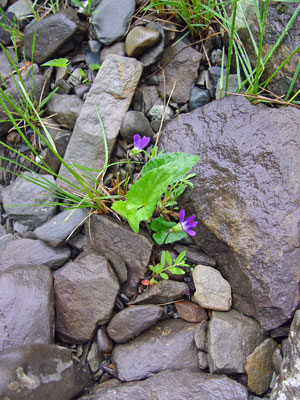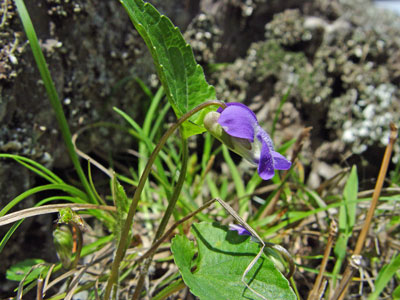DACF Home → Bureaus & Programs → Maine Natural Areas Program → Communities, Plants, and Animals → Rare Plants → Viola novae-angliae

Viola novae-angliae L.
New England Violet
- State Rank: S2
- Global Rank: G4
- State Status: Special Concern
Habitat: Gravels, wet rocks, shores and meadows. [Non-tidal rivershore (non-forested, seasonally wet)]
Range: New Brunswick to Maine, New York, northern Michigan to northern Wisconsin, northwestern Ontario to southern Manitoba.

Aids to Identification: The New England violet is a perennial herb with thick, short rhizomes. It has narrow, triangular leaves (longer than wide), heart-shaped at the base with shallow rounded teeth along the margin. The mature leaves are 2-7 cm long and 2-5 cm broad. A distinctive feature is that the blades, petioles, and peduncles are all pubescent. The plants are stemless and do not produce stolons. Flowers are purple, and the upper petals are often recurved.
Ecological characteristics: Viola novae-angliae is rare throughout its range; little or no information is available on its ecology. In Maine, it is restricted to calcareous slate ledges of the lower Penobscot, St. John, and Allagash Rivers. It typically grows on ledges projecting into the river, well below the spring high-water line. Usually, the plants are above the water level for all of the growing season, although unusually intense summer rains may temporarily flood the plants.

Phenology: A perennial; in Maine, flowers in early June.
Family: Violaceae
Synonyms: Viola sororia var. novae-angliae (House) McKinney.
Known Distribution in Maine: This rare plant has been documented from a total of 19 town(s) in the following county(ies): Aroostook, Penobscot, Somerset.
Reason(s) for rarity: Naturally small range. Probably dwindling due to habitat loss. Also unknown factors.
Conservation considerations: Known populations are small but not currently subject to any particular human threat; the plant seems to persist on the few river ledges where it grows. Heavy recreational use of ledges could pose problems.